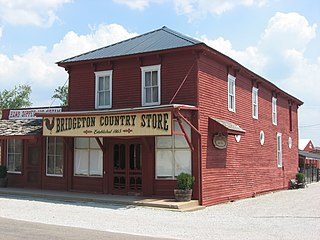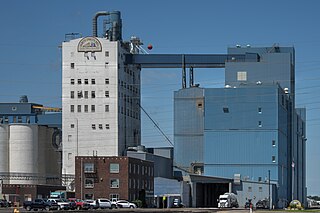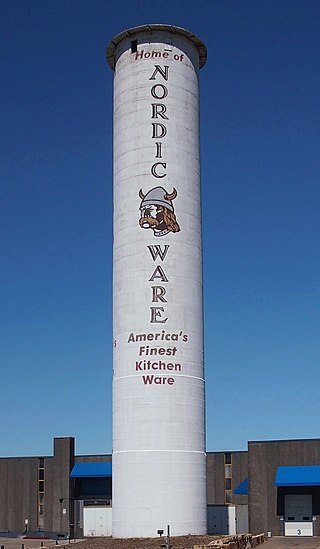
A grain elevator or grain terminal is a facility designed to stockpile or store grain. In the grain trade, the term "grain elevator" also describes a tower containing a bucket elevator or a pneumatic conveyor, which scoops up grain from a lower level and deposits it in a silo or other storage facility.

Bale Grist Mill State Historic Park is a California state park located in Napa County between St. Helena and Calistoga. The park is the site of a water-powered grist mill that was built in 1846 is one of only two water-driven mills remaining west of the Mississippi River.

Bridgeton is an unincorporated community and census-designated place in Raccoon Township, Parke County, in the U.S. state of Indiana. It is notable for its covered bridge, which was destroyed on April 28, 2005, by a fire set by an arsonist. A historically accurate reconstruction of the bridge was completed in October, 2006.

Watson's Mill is an historic flour and gristmill in Manotick, Ontario, Canada. It is the only working museum in the Ottawa area and one of the very few operating industrial grist mills in North America. Watson's Mill still sells stone-ground whole wheat flour which is made on site. The mill is also well known for its ghost Annabelle. The legend is that Ann Currier, wife of Joseph, haunts the mill, following her death in a tragic accident there in 1861. Watson's Mill is Manotick's most recognized landmark. Its image is used as a symbol for the village.

The North Dakota Mill and Elevator is the largest flour mill in the United States. It is located in the city of Grand Forks, North Dakota. Established by the state government when it was led by Nonpartisan League representatives, it is the only state-owned milling facility in the United States. It is overseen by the North Dakota Industrial Commission, whose members are all public officers elected by popular vote.

The Peavey–Haglin Experimental Concrete Grain Elevator is the world's first known cylindrical concrete grain elevator. It was built from 1899 to 1900 in St. Louis Park, Minnesota, United States, as an experiment to prove the design was viable. It was an improvement on wooden elevators that were continually at risk of catching fire or even exploding. Its cylindrical concrete design became the industry standard in the United States, revolutionizing grain storage practices. After its initial experiments, the Peavey–Haglin Elevator was never again used to store grain. Since the late 1960s it has been maintained on the grounds of the Nordic Ware company and is painted with their name and logo.

Northwestern Consolidated Milling Company Elevator A also known as the Ceresota Elevator and "The Million Bushel Elevator" was a receiving and public grain elevator built by the Northwestern Consolidated Milling Company in 1908 in Minneapolis, Minnesota in the United States. The elevator may have been the largest brick elevator ever constructed and ran on electricity. The elevator was the source for the Crown Roller Mill and Standard Mill. Those mills closed in the 1950s but the elevator continued in use for grain storage until the mid 1980s. The building is a contributing property of the St. Anthony Falls Historic District listed in the National Register of Historic Places in 1971. For this article north is toward the river.

The Luethstrom–Hurin House is a historic residence in the city of Wyoming, Ohio, United States. Erected in the 1860s and profoundly modified before 1875, it was the home of two prominent businessmen in the local grain and flour industry, and it has been designated a historic site because of its architecture.

The following are all the contributing resources to the Saint Anthony Falls Historic District in Minneapolis, Minnesota, United States. The District is listed on the National Register of Historic Places, thus these properties are on the NRHP. The "period of significance" of the District was 1858–1941. The district's archaeological record is considered to be one of the most-endangered historic sites in Minnesota.

The Sheridan Inn is a historic hotel in Sheridan, Wyoming. Designed by the architect Thomas R. Kimball of Omaha, Nebraska in 1893, it was constructed by the Chicago, Burlington, and Quincy Railroad as part of its development program in Wyoming associated with extension of the railway. Equipped with the first bathtubs and electric lights in that part of Wyoming, the inn was considered the "finest hotel" between Chicago and San Francisco. It was declared a National Historic Landmark in 1964.

Hook Windmill, also known as Old Hook Mill, is a historic windmill on North Main Street in East Hampton, New York. It was built in 1806 and operated regularly until 1908. One of the most complete of the existing windmills on Long Island, the windmill was sold to the town of East Hampton in 1922. The building was listed on the National Register of Historic Places in 1978 and is part of the North Main Street Historic District. The mill was renamed the "Old Hook Mill" and is open daily to visitors.

The Landmark Inn State Historic Site is a historic inn in Castroville, Texas, United States. It serves the general public as both a state historic site and inn eight overnight rooms.
Toomey's Mills in Newcastle, Wyoming, began in 1905 as the Newcastle Milling Company and Electric Light Plant. Later the Newcastle Rolling Mills, Toomey's Mills processed locally produced wheat until 1965. The mill is a prominent local landmark, with "TOOMEY'S MILLS" painted on the side of the elevator. It is today used as a restaurant, an example of adaptive reuse. Much of the original mill machinery has been retained, and the property retains a significant degree of integrity.

Mill City Museum is located in the ruins of the Washburn "A" Mill next to Mill Ruins Park on the banks of the Mississippi River in Minneapolis. The museum, an entity of the Minnesota Historical Society that opened in 2003, focuses on the founding and growth of Minneapolis, especially flour milling and the other industries that used hydropower from Saint Anthony Falls. The mill complex that the museum is within, dates from the 1870s and is listed on the National Register of Historic Places. It is also part of the St. Anthony Falls Historic District and within the Mississippi National River and Recreation Area.
The Esterhazy Flour Mill is located at 517 Smith-Dorrien Street, Esterhazy, Saskatchewan. Construction of the mill was started in 1904 and was completed in 1907. The current owner is the Town of Esterhazy and is run by the Friends of the Flour Mill. The Esterhazy Flour Mill is the only remaining wood-frame construction flour mill in Saskatchewan. The Provincial Heritage Property designation was announced in 2005 and on July 8, 2009, the Esterhazy Flour Mill was designated as a National Historic Site.

Hodgson-Aid Mill, also known as Hodgson Water Mill and Aid-Hodgson Mill, is a historic grist mill located on Bryant Creek near Sycamore, Ozark County, Missouri. It was constructed around 1897, and is a 3+1⁄2-story, timber frame mill building covered with red-painted weatherboards. Associated with the mill are the man-made mill pond and the limestone barrel vault constructed at the base of the cliff where Hodgson Spring discharges. The mill has not been in operation since 1976. It is privately owned.

The Cheyenne Flour Milling Company, also known as the Standard Oil Company and Salt Creek Freightways, is an early warehouse building in Cheyenne, Wyoming. The structure was built in 1927 to house goods brought to and from Cheyenne by the Union Pacific Railroad in an industrial section of Cheyenne as a flour mill, replacing structures that had performed similar functions since 1915. By 1931 the building was shared by a warehouse for electrical parts for the Mountain States Telephone and Telegraph Company, a potato chip factory and a chemical products company. In 1937-38 the Standard Oil Company started to use the warehouse for bulk petroleum products storage, continuing to 1963. From 1963 the building was used by Salt Creek Freightways, which had shared use from 1936. In 1973 it became a plumbing parts warehouse, and by 2003 was owned and used by a general contractor.

The Archer Daniels Midland Wheat Mill was a plant in Chicago's Fulton Market District. The complex included brick loft buildings, a grain elevator, and silos. The oldest buildings in the complex were built in 1897 and were designed by William Carbys Zimmerman and John J. Flanders. It originally served as Eckhart & Swan's wheat and rye mill.

The Historic Ely Elevator, also known as the Woitishek-King-Krob Elevator and Feed Mill, is an "iron-clad" wood-cribbed grain elevator, located in Ely, Iowa. The Historic Ely Elevator was built in 1900 along the Burlington, Cedar Rapids and Northern Railway. It is a contributing property of the Dows Street Historic District, which is listed on the National Register of Historic Places.



















